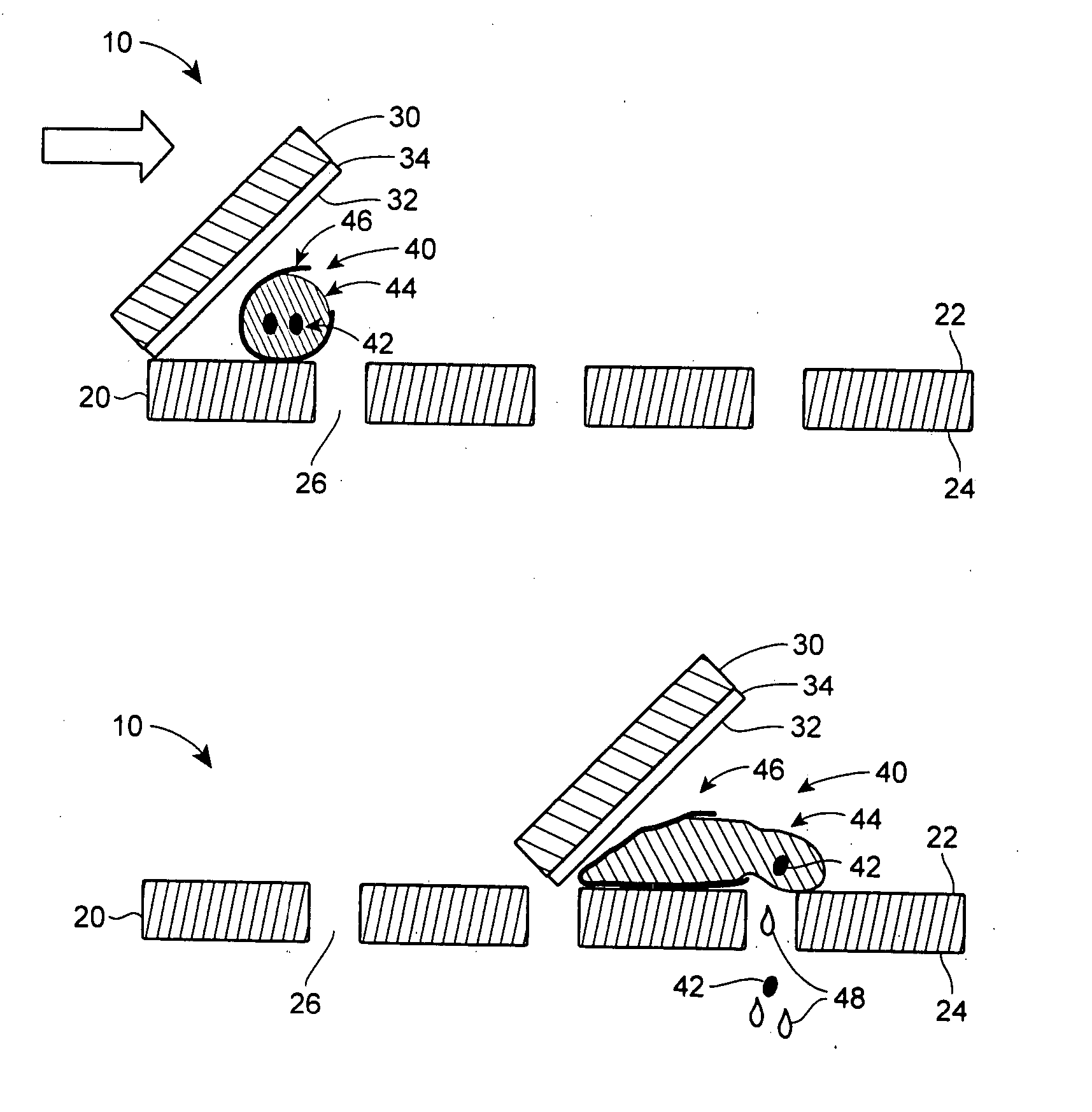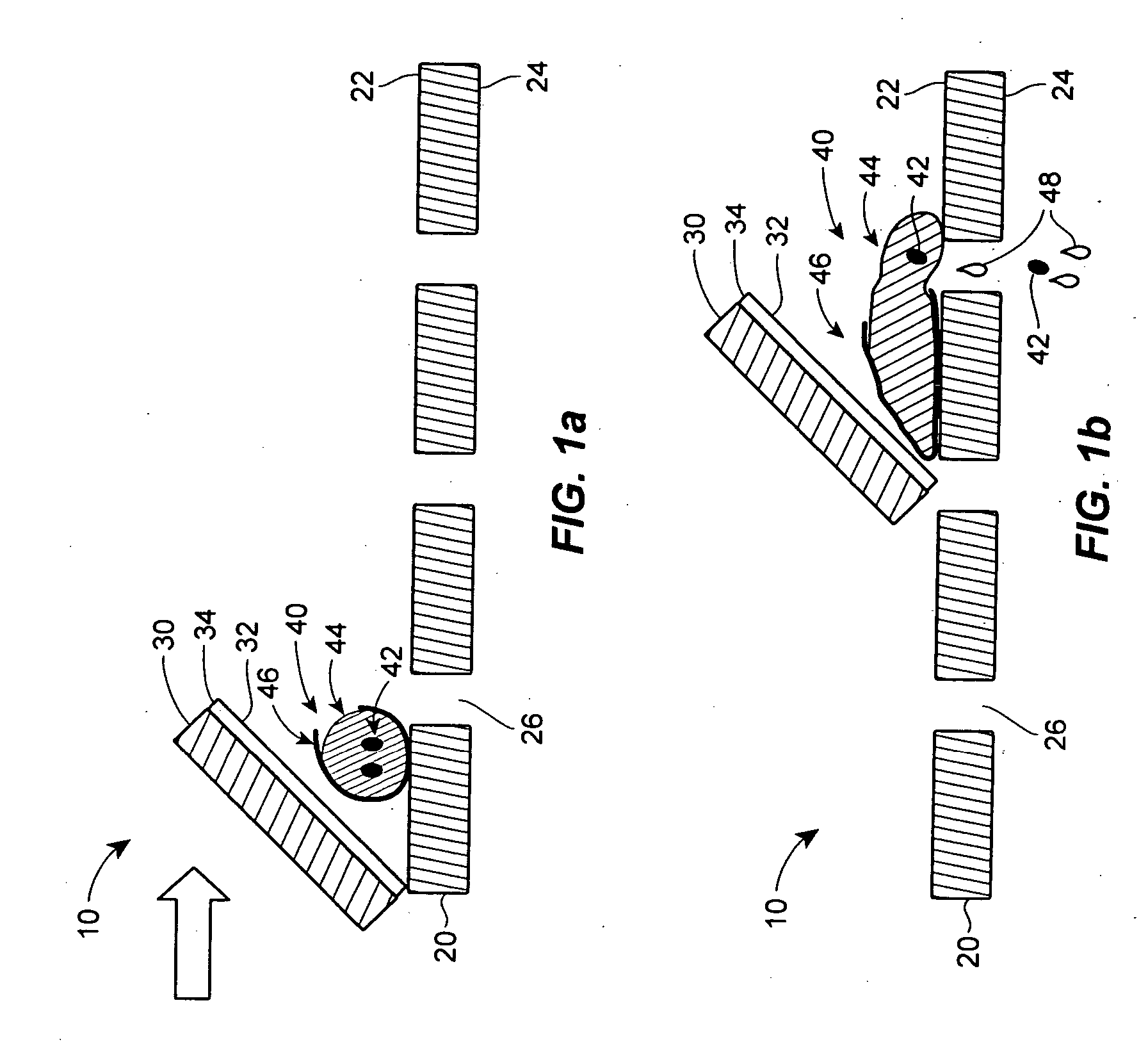Method and apparatus for removal of grape seeds from grape skin
a technology of grape skin and grape seeds, which is applied in the field of grape skin removal methods and equipment, can solve the problems of unsatisfactory qualities, many such methods are impractical on a large scale, and it is difficult to separate the solids portions from each other, so as to avoid the disadvantages of increased expenses and negative effects on wine quality, improve the yield of juice obtained from grape berries, and avoid the effect of increasing the cos
- Summary
- Abstract
- Description
- Claims
- Application Information
AI Technical Summary
Benefits of technology
Problems solved by technology
Method used
Image
Examples
example 1
[0101] According to this example, a device according to the invention is used to separate seeds from skins in grape must. FIGS. 1a and 1b depict a schematic representation of the device 10 of the invention. Device 10 comprises a plate 20 having a first side 22 and a second side 24 having a plurality of apertures 26 there through having sizes through which grape seeds and juice are capable of passing. The device further comprises a blade 30 having a grape contacting face 32 which can have an elastomeric coating 34. According to one version of its operation, intact and / or crushed grapes 40 comprising one or more seeds 42, pulp 44 and skin 46 are deposited on the first side 22 of the plate and are contacted by the grape contacting face 32 of blade 30 which is disposed adjacent the plate 20 and is driven parallel to the plane of the plate 20. The blade face 32 is disposed in a manner, in this case by forming an acute angle with the plane of the plate 20, such that as it is driven across...
example 4
[0109] According to this example, a method of pretreating grape berries to open the fruit and better expose and separate the mucilage from the seeds was carried out in accordance with this invention. These exposed seeds could then be easily and very efficiently separated from the skins. Specifically, 520 grams of hand destemmed Merlot grape berries were crushed in a small laboratory crusher, producing 302 grams of seeds / skins / mucilage and 218 grams juice. A 200 gram quantity of the seed / skin / mucilage was mixed with 218 grams of grape juice and with 300 ml of 20% sugar solution to produce a thinner slurry mix.
[0110] After mixing for 10 seconds with a small electric mixer, the slurry was placed in a laboratory Waring blender and the blender knives were run at 10,000 rpm for 15 seconds. Due to vortexing during the blending some foam was produced and the entire contents of the blender were then placed into a funnel with the exit neck closed, in order to allow the entrained air to separ...
example 5
[0113] While the preceding examples demonstrated the utility of the batch-style grape berry pretreatment and seed / skin separation methodologies, there remains a need for continuous processes for grape pretreatment to open the berries as well as for continuous processes for seed / skin separation. According to this example, an apparatus 250 is depicted in FIG. 5 by which grape berries can be opened in a continuous mode was constructed comprising a tube 260 twelve inches long and four inches in diameter having an inlet 262 and an outlet 264. The tube has a shaft 270 running along the center of its axis on which are three, four-bladed knives 272 mounted for axial rotation. The shaft was connected to a variable speed motor (not shown) whose speed could vary from 2000 to 6000 RPM.
[0114] Ninety pounds of grapes were destemmed and crushed in an industrial destemmer / crusher and then mixed with 90 pounds of 25% sugar solution (to simulate the juice recycle stream needed for slurry dilution.) ...
PUM
 Login to View More
Login to View More Abstract
Description
Claims
Application Information
 Login to View More
Login to View More - R&D
- Intellectual Property
- Life Sciences
- Materials
- Tech Scout
- Unparalleled Data Quality
- Higher Quality Content
- 60% Fewer Hallucinations
Browse by: Latest US Patents, China's latest patents, Technical Efficacy Thesaurus, Application Domain, Technology Topic, Popular Technical Reports.
© 2025 PatSnap. All rights reserved.Legal|Privacy policy|Modern Slavery Act Transparency Statement|Sitemap|About US| Contact US: help@patsnap.com



